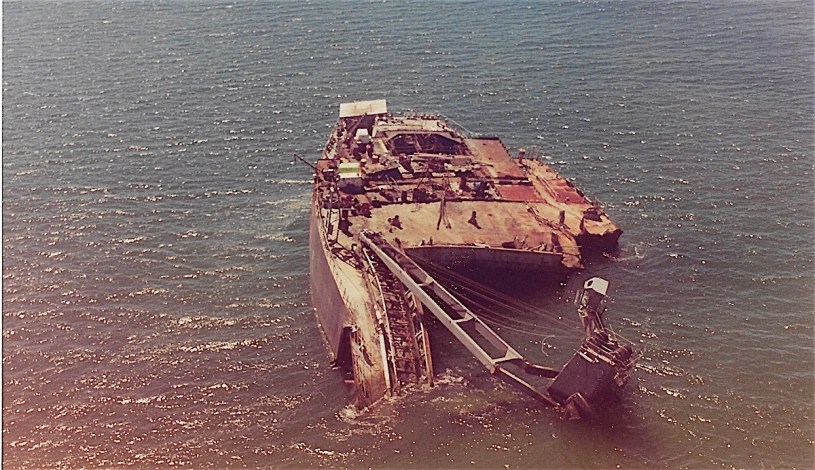By Alison Bate, Published 1999
Walking on the New Carissa is a precarious business.
The wreck, embedded in soft sand off the Oregon coast, has an 11-degree list and an 11-degree trim. Walking around, we brace hard against the slope.
First impressions are of rust, mangled steel, pipes and wire. The tiny helicopter pad, built near the stern, is the only clear level surface in sight.
After all, the poor wood chip carrier has been battered by the surf, set on fire, and split into two pieces since it ran aground in a storm on Feb. 4.
The bow was finally scuttled offshore by the U.S. Navy. Now, more than 40 people are hard at work preparing the 200-foot stern section for a similar fate.
Portland’s Fred Devine and Salvage Co. and Donjon Marine, based in New Jersey, are working in a joint venture to remove the wreck.They’re working in the surf zone on a isolated sandy spit, just north of North Bend and Coos Bay in southern Oregon.
Donjon’s main equipment arrived via the Panama Canal and includes the 7,000-horsepower anchor-handling tug Atlantic Salvor, the 400-ton rated capacity derrick barge Columbia New York, and the crew boat Matthew Scott.
The other key player is Fred Devine’s 3,600-horsepower salvage vessel, Salvage Chief, usually based in Astoria, Oregon.
As we land on the New Carissa , Mick Leitz and Danny Dugan are on deck, adjusting towlines connecting the wreck to the Salvage Chief. Leitz is president of Fred Devine and Salvage Co.

Today, the Salvage Chief is displacing sand to increase the amount of working time available to the Columbia New York. So far, the barge can only work some areas of the wreck at high tide. More than 500 tons of material have been removed by now, both by barge and by helicopter.
Down below, we pass along a scarred passageway and look into a hold filled with seawater. Bubbles rising from the murky green water are the only clue that a diver is down there.
Nearer the stern, diver Jessie Hutton is cleaning his face mask. “It’s dark, but relatively clean in there,” he said. “But it’s pretty tough because we try to keep up with the sand.”
He’s one of seven divers working on the New Carissa, cutting out piping, removing sand and trying to patch the aft engine room section. The sand is a pain to work with. As fast as they clear it out, it flows back in. But by early August, it’s estimated 90 percent of the sand has been removed from the engine room.
Oil is the sensitive issue, of course. The engine room still contains fuel, although it’s not clear how much remains.
Assuming the aft engine room section can be sealed properly, the plan is to cut it free from the rest of the wreck. This section will then be towed to deep water and sunk, and the remaining wreckage cut up and disposed of on land. Alternatively, crews will have to chop up the whole wreck in pieces.
Back on land, Arnold Witte, president of Donjon Marine, discussed some of the problems facing them.
“It’s a difficult job to seal the engine room. There are numerous holes above the lower forehead engine room bulkhead.” He added, though: “I expect that within the next month, we will make the engine room tight.”
Witte said the weather is the main difficulty. “It’s severely complicated because we’re working in the surf zone,” he added. “It’s very difficult to keep equipment stable. The other problem is that the wreck is embedded more than 20 feet into the sand.”
However, they hope to float the wreck off by October, before the winter storm season begins. The two companies are not expecting any difficulties getting approval for sinking the wreck. “Environmentally it’s clearly the best option,” Witte explained.
Without a doubt, there’s still a long way to go before this stubborn wreck leaves the Oregon shore.
© Marine Digest, September 1999/Pix updated November 2020
RELATED:
* YouTube video from KEZI 9 News: New Carissa Founders Off Coos Bay
